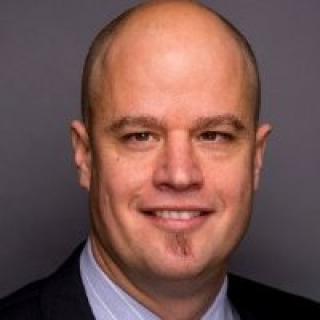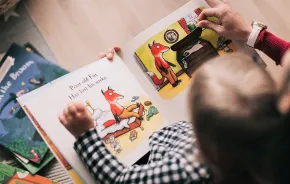How does a place like Seattle become known for something as nebulous as innovation?
Ask an adult, and he will tell you it’s because we have good ideas, an entrepreneurial spirit, grit and, most importantly, money. Ask a kid what you need to be innovative, and she’ll tell you all you need is creativity.
“Seattle is a city that believes in the power of a good idea — and then invites everyone to the table to take that idea to the next step,” says Leonard Garfield, executive director of the Museum of History & Industry (MOHAI) and the Bezos Center for Innovation within it. “We’re a city that focuses on the future more than the past, always on the lookout for the next big thing.”
Today, the next big thing is growing out of a new generation of Seattle-area thinkers and tinkers of all ages, who are sowing seeds of innovation in technology, science and social progress that are having an impact on kids and families not just around the region, but across the globe.
Roots of innovation
The “Seattle effect” harks back to the Pacific Northwest’s ancestors: Early Native Americans invented gill nets and weirs to catch life-giving salmon; 50-foot-long red cedar canoes for fishing and transport; and longhouses, where they could shelter, enjoy their abundant food supply and do something that gave them an edge: dream up new ideas.
The innovations kept coming, like a chain reaction, after European settlement: the timber industry, then shipbuilding, PACCAR’s heavy-duty trucks and Nordstrom’s customer-friendly retail emporium. More recently, a surge of companies pioneered how to go big with new ideas. Boeing, Microsoft, Starbucks, Amazon and Costco are the most well-known ones, but there are many more.
 “This growth is like compound interest — the good ideas keep leading to yet more good ideas, and happily, Seattle becomes the hub of creativity, innovation and the people who thrive in that environment,” Garfield says.
“This growth is like compound interest — the good ideas keep leading to yet more good ideas, and happily, Seattle becomes the hub of creativity, innovation and the people who thrive in that environment,” Garfield says.
And today that interest is paying off, from the Bill and Melinda Gates Foundation’s work to enable people in the Third World to jump the digital divide, to advances in health care driven by the vibrant biomedical community, to a long list of startups feeding off the community’s technological savvy.
Garfield says Seattle has all the ingredients of a uniquely innovative place: a willingness to welcome newcomers; a strong middle class that values education and civic participation; an economy built over time on engineering, education and technology; and a collegial spirit in which folks from different fields frequently get to rub shoulders and, in the process, create the synergy to discover what’s next.
The biggest challenge to new ideas might be what Garfield calls the “corrosive effect of underfunded schools and social inequity.”
The solution, he says, is to close the gap.
“We need everyone to get the best education from the earliest age, and we need to ensure that there is not a divide between those engaged in the innovation economy and those on the outside looking in,” he says.
Feed those young minds, and they will pay you back. “Kids in Seattle are natural-born innovators,” Garfield says. “They know technology and they have passion for new ideas.”
Inside MOHAI, through interactive museum displays designed to spark imagination and ingenuity, optimistic youths share their ideas every day.
“Just today some young people explored their concept for the next big innovation — one was a flying backpack, and another was chips implanted in your body so you have a built-in computer to help guide you through life,” Garfield says. “And my guess is these kids may work on bringing those ideas to reality in their own time.”
But perhaps the most important key to raising innovative kids is to model ground-breaking ideas, which, it turns out, we are doing in spades.
Cornering cancer
The challenge: Cure childhood cancer
The solution: Reprogram the cells that fight the common cold
Draw blood from a child, teen or young adult fighting cancer. Reprogram it, instructing the T-cells that the patient normally uses to fight colds and other common infections to instead attack her leukemia. Inject that modified blood back into her bloodstream. Wait 10 days and marvel when all traces of cancer are gone from her bones.
That’s what early trials conducted at the Ben Towne Center for Childhood Cancer Research — part of the Seattle Children’s Research Institute — suggest will happen. In those trials, 85 percent of patients saw their cancer disappear completely.
Whoa, really? It makes you wonder how we got here.
Traditional cancer treatments such as chemotherapy often don’t work well for children for a simple reason: Such treatments ravage young bodies. So even when these patients beat cancer, they often lose because of permanent damage that affects them for the rest of their lives.
 It was nearly four years ago that pediatric cancer researchers from Seattle Children’s Research Institute met with Jeff and Carin Towne, who had lost their son Ben to pediatric cancer. The Townes wanted to do something to fight cancer in kids, and Dr. Mike Jensen and a group of fellow researchers needed funding to test their notion that the body’s own defense mechanisms could be used to fight cancer without ugly side effects.
It was nearly four years ago that pediatric cancer researchers from Seattle Children’s Research Institute met with Jeff and Carin Towne, who had lost their son Ben to pediatric cancer. The Townes wanted to do something to fight cancer in kids, and Dr. Mike Jensen and a group of fellow researchers needed funding to test their notion that the body’s own defense mechanisms could be used to fight cancer without ugly side effects.As a result, the Ben Towne Center for Childhood Cancer Research was born. “They became the angel funders for getting this research center off the ground,” says Jensen, director of the center and a principal investigator within Seattle Children’s Research Institute.
From day one, the spirit of the nonprofit research center was to move as quickly as possible to help children. The decision was made to locate the center in an old biotech building in downtown Seattle’s Denny Triangle, because it included a factory that would allow the researchers to quickly build and manufacture the products that they invented in the lab. It also helped that the larger Seattle Children’s Research Institute is located there.
Within two years of opening the facility, the researchers were ready to test their reprogrammed T-cells. Using a technique called immunotherapy, they targeted lymphoblastic leukemia, a common childhood cancer that looked promising for this treatment because it floats around in the blood — the same place that the T-cells live.
Because it’s such early days for the therapy (researchers are working as quickly as possible to help real kids who were losing their lives), the center can only treat children whose cancer has relapsed and no longer responds to other treatments. Patients who undergo the therapy would have only a 10–20 percent chance to live if they were to stick with standard treatment. Because of the experimental nature of the therapy, the center can only treat one patient at a time and has to wait to see how he or she responds before treating another. For that reason, only 17 children had been treated by the end of January.
The treatment lasts 15 minutes. “There are no side effects, no vomiting,” Jensen says. “For most of the patients, the T-cells think they’re fighting a bad case of the flu.” The flu symptoms go away after two days for most patients. One in four gets sick enough that they have to be hospitalized for what is basically a very bad case of the flu. (This could be caused by the fact that their immune systems have been weakened by previous cancer treatments.)
A small percentage of patients have not responded to the treatment, but the cancer has completely disappeared in 85 percent of those who received it. In those patients, the cancer has been officially designated as being in remission. (Doctors won’t say the “cure” word until the cancer is gone for five years.)
The center has received inquiries from doctors and families around the world wanting to try the treatment. Parents of the children who have received the treatment have been blown away, and how could they not be? Going from knowing your child has almost no chance to live (“planning for hospice and funeral homes,” Jensen says) to being told your child is in complete remission is nothing less than remarkable.
The center is moving as quickly as possible to treat more children, but it will take three to five years to properly test the treatment and get needed approvals. “We’d like this therapy to be used right in the beginning, so you don’t have to use chemotherapy,” Jensen says.
The center also plans to see how the treatment works on other pediatric cancers (and eventually, on adult cancers).
Jensen envisions a manufacturing lab in Seattle to which doctors send their patients’ blood from places like Boise, Tallahassee and Bangladesh. The center would reprogram the blood and send it back to the patient for treatment.
Taking this entrepreneurial spirit a step farther, the center is already working to get the private sector to help it mass-produce treatment for common cancers.
To support this research, Seattle Children’s launched Strong Against Cancer, a fundraising initiative designed to support cancer immunotherapy research at Seattle Children’s Research Institute. Seattle Seahawks quarterback Russell Wilson is its team captain.
Training up
The challenge: Go from poverty to professional position in one year
The solution: Boot camp training at Year Up Puget Sound

At first, Desirae Murphy, a 24-year-old cosmetologist from Seattle’s Central District who was cutting hair because “people told me I was good at it,” thought it was a scam — too good to be true.
Year Up Puget Sound was going to pay her to go to school, help her get an internship doing the project management that she always wanted to do and give her life skills training, the kind that would prepare her for working in a corporate environment. All in a year’s time.
She soon found out it was true: Year Up Puget Sound would pay her modestly while it trained her and sent her to Bellevue College for classes and certification. It also would help Murphy find an internship at Microsoft, one of the sponsors of the program.
“No one had really told us what it takes to go into a corporation and find a place there,” Murphy says. “They helped me go into Microsoft and meet professionals at all levels. It’s basically teaching you how to manage life.”
Year Up Puget Sound was formed in 2011 to help low-income young people gain the training and skills they need to land professional jobs — jobs that would change the trajectory of their lives.
“Knowing what these young people need to be successful, we provide lots of support,” says Ali Friedman, director of development for the program’s Puget Sound–area location (there are about a dozen other local sites around the country). That ranges from counseling to making sure they have full bellies and a ride, to, most importantly, helping them stay motivated to show up every day and work at it.
Knowing there are real jobs with major companies that pay well is what keeps participants motivated, Friedman says. “We provide the runway, and they provide the plane.”
There are more than 15,000 young adults in the Puget Sound region who do not have access to livable wage careers or higher education, and Year Up would like to help as many of those as it can, Friedman says. Eighty people enroll in the yearlong program every six months. More than 75 percent of its participants finish, and of those, 85 percent land jobs.
Along the way, they are helping their communities by changing perceptions and showing others that they can do it, too.
Year Up is a market-driven organization: It continually checks in with its corporate partners to see what kinds of jobs aren’t being filled and then restructures so that it’s training people to get those jobs. A combination of corporate donations, internships and mentorships support the program.
As for Murphy, she graduated from the program at the end of February and found herself choosing between multiple offers to work at Microsoft and other companies.
The way wasn’t easy, but it was oh so rewarding.
“The program really works, but you have to allow it to work for you,” Murphy says. She resisted at first, but says, “You have to be able to take feedback. There’s a lot of holding you accountable,” she says. “It makes a difference in people’s lives.”
Clever ventures
The challenge: Fund and launch the next great idea
The solution: Game-show-style coaching and financial support
“Jump on stage and give me your best shot: How are you going to save the world?”
That’s the question Eli Weed was asked when he went through Fast Pitch, the Seattle-based idea generator funded by Social Venture Partners (SVP) that takes an approach similar to that of TV’s Shark Tank.
 Weed is a 16-year-old high school junior from Seattle who had an idea: to make it easier for kids with dyslexia to learn how to type.
Weed is a 16-year-old high school junior from Seattle who had an idea: to make it easier for kids with dyslexia to learn how to type.
Last spring, Weed submitted his DyslexiType typing software program to Fast Pitch, was accepted into the contest’s high school category and proceeded to advance through several rounds of competition to eventually emerge as the category winner (and recipient of a $10,000 check) in October.
Along the way, he was challenged, coached, put on stage, grilled, reshaped and made to rethink his idea from all angles. By the end of it, he had a product ready to be tested, a business plan for growing and marketing his company, and a thicker skin. “Now, presentations at school don’t seem quite that scary,” he quips.
DyslexiType uses color coordination and a friendly font to make it easier for typists to find their keys. Once they can find the letters without looking at them, they do much better, Weed says.
As part of SVP’s program, competitors with ideas in many disciplines (education, business, science and technology, social) get on stage, present their concepts and receive real-time feedback, says Maureen O’Hara, recent lead partner for Fast Pitch. (The volunteer role changes hands each year.)
Experts in the various project subjects volunteer as judges. “Besides money, the coaching is the most valuable thing that they receive,” O’Hara says.
Others who have gone through Fast Pitch include Evrnu, which turns wasted cloth into silk and other high-quality materials; Scholarship Junkies, a group of recent scholarship recipients and mentors who give essay writers feedback to help them land their own scholarships; and Unleash the Brilliance, which provides kids an alternative to truancy, bullying, negative peer pressure and drugs.
Another recent competitor was Tiny Trees, which slashes the cost of preschool by getting rid of the classroom altogether.
“Tiny Trees makes preschool affordable for families by tackling the root of the problem — facility and building costs,” Andrew Jay, CEO, says. “We break down the schoolhouse walls and take classes outside to local city parks, where we combine quality math and reading instruction with a world-class science education.”
The solution is taking root. Fast Pitch awarded Tiny Trees a first-place finish in October, giving it $15,000 to kick-start its big plans, which include launching 20 Tiny Trees preschools by 2020.
Citizen power
The challenge: Awaken the masses
The solution: Inspire involvement and personal responsibility
Americans are ready to be citizens again. Just ask Eric Liu, founder and CEO of Seattle-based Citizen University.
“We’ve been living in an age where citizen power and citizen engagement has been diminishing,” Liu says. “We now have a culture where everyone is more aware of their power as consumers than they are aware of their power as citizens.”
But that is changing.
 Look at the conversation the nation is having about law enforcement after Ferguson. Recall the local grassroots push to raise the minimum wage to $15, first in SeaTac and then in Seattle. Consider the growing gun-safety activism that came after Sandy Hook, including the recent passage of Initiative 594, the law that requires universal background checks in Washington state. And don’t forget the lasting legacy of the Occupy Wall Street and Tea Party movements.
Look at the conversation the nation is having about law enforcement after Ferguson. Recall the local grassroots push to raise the minimum wage to $15, first in SeaTac and then in Seattle. Consider the growing gun-safety activism that came after Sandy Hook, including the recent passage of Initiative 594, the law that requires universal background checks in Washington state. And don’t forget the lasting legacy of the Occupy Wall Street and Tea Party movements.
All are driven by the power of citizens deciding to “stop thinking this is someone else’s problem to solve,” Liu says. “Now the tide is turning. We’re starting to exercise our citizenship muscle. [We have an] unformed, bottom-up yearning for agency, voice and power.”
Liu formed Citizen University four years ago to help those who have taken a first step into the civic arena to take a second. Liu, along with Nick Hanauer (they are coauthors of The True Patriot and The Gardens of Democracy), played a pivotal role in helping the activists behind the minimum-wage and gun-safety measures become organized and powerful enough to gain approval.
Liu’s organization isn’t a traditional university; the title is a euphemism for teaching people how to become activists, to agitate for change in their communities. Citizen University holds events, teaches online classes, promotes civic collaborating and, most importantly, helps people build structure around how they want to grow their activism.
Seattle is the perfect place to lead this conversation, Liu says, because it is filled with creative, entrepreneurial people who share ideas, build amazing stuff and then go big. Feeding off the energy of others is what makes the community special, Liu says. “If you really want to make change, you need to create networks inside of networks. That’s a quintessential Seattle view.”
He invites those who are interested in citizen activism to attend his annual #CitizenUCon15 conference, March 20–21 in Seattle.
“We’re at the very beginning of a movement of citizen action,” Liu says, explaining that activism today is not just for fringe, radical people. “What we need now is middle-out citizenship. It is time for all of us to start showing up in citizen life.”
Generation 'gamer'
The challenge: Bring kids into STEM
The solution: Harness video game culture to incite learning
It turns out that making video games is almost as fun as playing them — if you know your science and math.
That’s what the folks at Redmond-based DigiPen Institute of Technology learned in 1994 when they decided to offer the nation’s first undergraduate degree in video game design. “We had a tremendous amount of applicants who were completely unprepared with prerequisite math, science or art skills,” says Raymond Yan, DigiPen’s senior vice president responsible for its ProjectFun program.
 ProjectFun spun out of DigiPen with the goal of harnessing the power and fun of making video games to get K–12 students interested in science and math. Today, the program offers more than 50 different courses, school and weekend programs, and camps that provide a comprehensive pathway for students ages 5–18 to study topics in computer science, engineering, mechanics, fine art, animation production, music and sound design, and game design. “Many of these programs now extend beyond an exploratory level and are preparatory in nature, offering the opportunity to earn high school and college level credit,” Yan says. “Our core goal is to provide our students with the keys that they will need to be innovators, which ultimately means they have to learn to be creators of technology and content, not just users or consumers,” he says.
ProjectFun spun out of DigiPen with the goal of harnessing the power and fun of making video games to get K–12 students interested in science and math. Today, the program offers more than 50 different courses, school and weekend programs, and camps that provide a comprehensive pathway for students ages 5–18 to study topics in computer science, engineering, mechanics, fine art, animation production, music and sound design, and game design. “Many of these programs now extend beyond an exploratory level and are preparatory in nature, offering the opportunity to earn high school and college level credit,” Yan says. “Our core goal is to provide our students with the keys that they will need to be innovators, which ultimately means they have to learn to be creators of technology and content, not just users or consumers,” he says.
Equally as important as foundational science and math skills is risk-taking.
“[Our] most difficult challenge [is] to teach students the value of failure, which is a critical concept to embrace when one is truly trying to innovate,” Yan says. “No one likes to fail, but when students are afraid of failure, they naturally run back to known solutions, which is not innovative. Getting all of this accomplished with students makes our programs challenging, yet the success of our graduates over the many years we have been teaching is the real proof that this approach works.”












